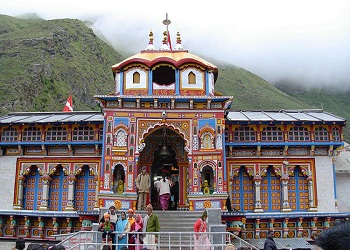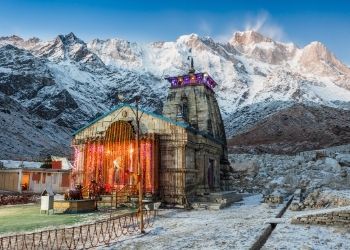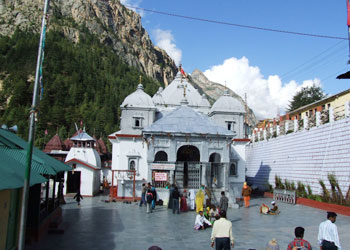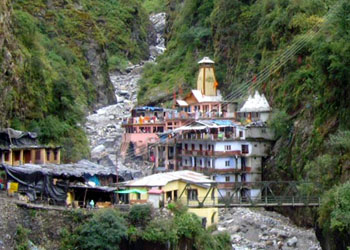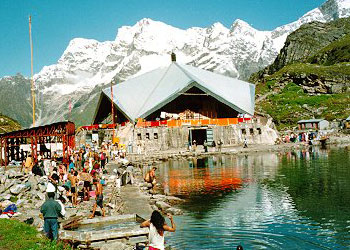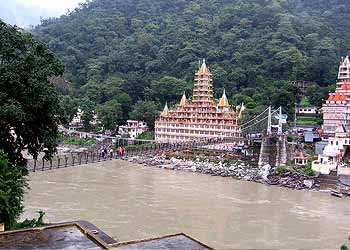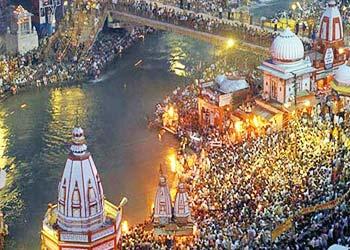Kedarnath Dham
want to know about
Kedarnath Dham
At Yamunotri & Gangotri, the pilgrims are cleansed body & soul and with having achieved purity in that sense, pilgrims to Sri Kedarnath becomes most rewarding. It is also customary to worship Lord Shiva with water of Ganga, which pilgrims going from Gangotri as well take some there to Kedarnath. Kedarnath is the seat of Lord Shiva. It is one of the twelve "Jyotirlingas" of Lord Shiva. Lying at an altitude of 3584 m at the head of river Mandakini, the shrine of Kedarnath is amongst the holiest pilgrimage for the Hindus. It is no wonder that Adi Guru Shankaracharya - a great scholar & saint, chose to enshrine Lord Shiva in this land, where the unholy becomes oly and the holy becomes holier. It is the place where Lord Shiva absolved Pandavas from the sin of killing their own cousins Kauravas in the battle of Kurukshetra. The origin of the revered temple can be found in the great epic Mahabharat.
At Kedarnath there are several Kunds (pools, tanks) that are known for their religious significans - shivkund, Retkund, hanskund, Udakkund, Rudhirkund are the most important. A little away from Kedarnath is a temple dedicated to Bhaironathji who is ceremoniously worshipped at the opening & closing of Kedarnath. The belief is that Bhairavnathji protects this land from evil during the time when temple of Kedarnath is closed.
During the winters, the shrine is submerged in snow & hence is closed. Fortunate are those who have good weather, but twice blessed are those who are at Kedarnath on a moonlit night- the snow peak gleams like hundred silver pinnacles atop the glittering mountains.
The other four places where Shiva is worshipped take their appearance from different parts of his body -the naval at Madmaheshwar, the arms at Tungnath, the face at Rudranath, and the matted hair at Kalpeshwar. The latter four along with Kedarnath are known as the Panch Kedars.
The holiest of Shiva's shrines is linked to Gold among base metals so that every pilgrims finds peace here, and it is said that devotees who die here become one with Shiva himself. Beyond the temple is the highway to heaven, called Mahapanth. According to legend, the place came into being during the period when the five Pandavas brothers were asked to seek Shiva's blessings purging them of the sin of killing their cousins. Lord Shiva unwilling to give darshans to the Pandavas frled Kashi to live incognito in Guptkashi, where eventually he was detected by the Pandavas. While fleeing Shiva took refuge at Kedarnath in the form of a bull and started to plunge underground when he was spotted by the Pandavas. He dived into the ground, leaving behind his hump on the surface. No wonder the natural rock formation that is worshipped here resembles the hump of a bull. Thus Shiva pleased with the determination of the Pandavas, exonerated them from their sin, gave them darshan & bestowed upon them the opportunity to worship his hump.
KEDARNATH TEMPLE
An imposing sight, standing in the middle of a wide plateau surrounded by lofty snow covered peaks. The present temple, built in 8th century A.D. by Adi Shankaracharya, stands adjacent to the site of an earlier temple built by the Pandavas. The inner walls of the assembly hall are decorated with figures of various deities and scenes from mythology. Outside the temple door a large statue of the Nandi Bull stands as guard.
Dedicated to Lord Shiva, the exquisitely architecture Kedarnath temple is considered to be more than 1000 years old. Built of extremely large, heavy and evenly cut gray slabs of stones, it evokes wonder as to how these heavy slabs had been handled in the earlier days. The temple has a "Garbha Griha" for worship and a Mandap, apt for assemblies of pilgrims and visitors. A conical rock formation inside the temple is worshipped as Lord Shiva in his Sadashiva form.
Kedarnath Dham Uttarakhand
Best Time to Visit Kedarnath Temple
Due to its elevation and geographical location, Kedarnath Temple remains open to the pilgrims for a period of six months. The end of April or beginning of the month of May is chosen for the opening of the portals of this high altitude sacred Hindu shrine. The temple closes right after Diwali and its deity is brought to Ukhimath where its worship continues for next six months of winter. Therefore the best time to visit Kedarnath Dham is between April and November with April to mid-June and October to mid-November being ideal most.
Kedarnath Temple Opening & Closing Dates 2024
The Kedarnath Temple opens every year in the month of April/May for the devotees and closes in winter around the third week of November. Thus, the temple is shut down for six months every year during which prayers to deity of Lord Shiva continues at Omkareshwar Temple in Ukhimath.
The dates for opening date of Shri Kedarnath Temple is announced by the priests on the auspicious day of Maha Shivaratri. This year in 2024, Kedarnath Temple shall open on May 14.
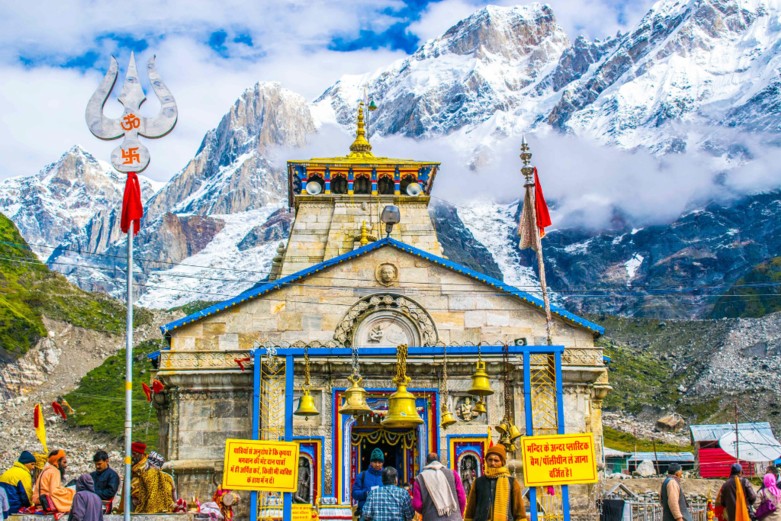
SIGHT SEEING & EXCURSION
Shankaracharya Samadhi : The Samadhi of Adi Guru Shankaracharya is located just behind the Kedarnath temple. It is said that after establishing four sacred Dhams in India, he went into his samadhi at an early age of 32 years.
Chorabari (Gandhi Sarovar) : Only 1 km trek away from Kedarnath. Floating-ice on the crystal clear waters of the lake fascinates the visitors.
Gaurikund : It is the base for a trek to Kedarnath and serves as a roadhead. The village has a temple dedicated to Gauri and hot water springs.
Trijuginarayan : According to legend, this was the place where the wedding of Lord Shiva and Parvati was solemnized. In front of the Shiva Temple is an eternal flame, which is said to be a witness to the marriage. It can be reached by a 12 km drive from Sonprayag.
Ukhimath : Winter home of the deity at Kedarnath temple and the seat of the Rawal of Kedarnath. Connected by bus services to Rudraprayag and other major centres.
Agastyamuni : The temple of sage Agastya is the main attraction here.
Madhmaheshwar : One of Panch Kedar, the temple of Madhmaheshwar is located at an altitude of 3,289 mt above sea-level, on the slope of a ridge, 25 km north-east of Guptkashi. There is a motorable road from Guptkashi to Kalimath. The best statue of Har Gauri in India measuring over a meter high is found in the Kali temple. The trek from Kalimath to Madhmaheshwar is distinguished by wild unparalleled scenic beauty and engulfed by Chaukhamba, Kedarnath and Neelkanth peaks. Gaundar at the confluence of Madmeshwar Ganga and Markanga Ganga, is the last settlement before one reaches Madhmaheshwar, the place where Lord Shiva is worshipped in the form of belly.
Tungnath : The arms of Lord Shiva came out as per the Kedarnath myth at Tungnath. He is worshipped here as one of the Panch Kedar. Tungnath Temple at an altitude of 3,680 mt, is the highest Shiva shrine among the Panch Kedar but the easiest to reach from Chopta, the nearest roadhead.
General Information
Area: 3 Sq. Km
Altitude: 3581 M
Rainfall: 1475 MM
Climate : Winter – Sept. to Nov. cold during the day & chilly at night. Dec. to march snow bound. Summer – May – Aug. Cool during the day & cold at night. Temp. Max. 17.9C & Min. 5.9 C Best Season: May – October, except Monsoon
Clothing : Light Woollens in summer & Heavy Woollens in winter.
Language : Hindi, English, Garhwali.
Accessibility :
Air : Nearest Airport, Jollygrant, 239 Kms.
Rail : Nearest Railway station, Rishikesh, 221 Kms.
Road : Kedarnath is approachable on foot from Gaurikund, which is connected by road with Rishikesh, Kotdwar, Dehradun, Hardwar and other important hill stations of Garhwal and Kumaon hills.
Local Transport : Horses, Dandies and Ponies are available at Gaurikund for going and carrying luggage to Kedarnath.
TALK TO OUR EXPLORE EXPERT
We're here to chat about your next big idea.
- 11 am - 6 pm Monday through Saturday.
Otherwise, email us anytime. On average we provide quotes within 6 hours during business hours and the next day during off business hours.
Privately guided trips allow you to be in control of all the details of your trip - departure times, accommodations, extra nights, extra activities, extra experiences - what you want and how you want it.

